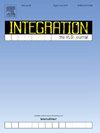A simulation optimization method for Verilog-AMS IBIS model under overclocking
IF 2.2
3区 工程技术
Q3 COMPUTER SCIENCE, HARDWARE & ARCHITECTURE
引用次数: 0
Abstract
The Input/Output Buffer Information Specification (IBIS) model has effectively described the electrical characteristics of circuit input and output ports while safeguarding intellectual property. This model focuses on the analysis of the analog behavior of digital integrated circuits, specifically focusing on the electrical characteristic of I/O buffers, by considering the voltage and current waveforms of the digital I/O signals. However, under overclocking conditions, the model experiences distortion and reduced accuracy due to decreased circuit stability. To address this limitation, we introduce an optimized model designed to resist simulation distortions in the IBIS model during overclocking. First, we defined the relevant variables based on the IBIS circuit and constructed a physical model framework. Next, we studied the monotonicity and sufficient conditions of the physical model, established the relationship between model output and variable parameters, and derived the corresponding IBIS mathematical relationship. Then, to address distortion under overclocking conditions, we adjusted the model variables by setting weighting coefficients tailored to different scenarios, ensuring the output values were closer to the baseline model and significantly enhancing the model's resilience against overclocking distortions. Extensive optimization experiments on three different devices confirm the general applicability of our proposed method, achieving optimization rates exceeding 90 % while maintaining high consistency with the TL baseline model. Notably, our approach improves overclocking simulation accuracy by 21.7 % with only a 2.2 % increase in CPU time, surpassing existing methods. This work addresses the IBIS model's overclocking distortion issue, significantly advancing the accuracy of circuit device simulations.
超频下Verilog-AMS IBIS模型的仿真优化方法
输入/输出缓冲信息规范(IBIS)模型在保护知识产权的同时,有效地描述了电路输入和输出端口的电气特性。该模型侧重于分析数字集成电路的模拟行为,特别是通过考虑数字I/O信号的电压和电流波形来关注I/O缓冲器的电气特性。然而,在超频条件下,由于电路稳定性下降,模型会出现失真和精度降低。为了解决这一限制,我们引入了一个优化模型,旨在抵抗IBIS模型在超频期间的仿真失真。首先,基于IBIS电路定义相关变量,构建物理模型框架;其次,研究了物理模型的单调性和充分条件,建立了模型输出与变量参数之间的关系,并推导出相应的IBIS数学关系。然后,为了解决超频条件下的失真问题,我们通过设置针对不同场景的权重系数来调整模型变量,确保输出值更接近基线模型,并显着增强模型对超频失真的弹性。在三种不同设备上进行的大量优化实验证实了我们提出的方法的一般适用性,在与TL基线模型保持高度一致性的同时,优化率超过90%。值得注意的是,我们的方法将超频模拟精度提高了21.7%,而CPU时间仅增加了2.2%,超过了现有方法。这项工作解决了IBIS模型的超频失真问题,显著提高了电路器件仿真的准确性。
本文章由计算机程序翻译,如有差异,请以英文原文为准。
求助全文
约1分钟内获得全文
求助全文
来源期刊

Integration-The Vlsi Journal
工程技术-工程:电子与电气
CiteScore
3.80
自引率
5.30%
发文量
107
审稿时长
6 months
期刊介绍:
Integration''s aim is to cover every aspect of the VLSI area, with an emphasis on cross-fertilization between various fields of science, and the design, verification, test and applications of integrated circuits and systems, as well as closely related topics in process and device technologies. Individual issues will feature peer-reviewed tutorials and articles as well as reviews of recent publications. The intended coverage of the journal can be assessed by examining the following (non-exclusive) list of topics:
Specification methods and languages; Analog/Digital Integrated Circuits and Systems; VLSI architectures; Algorithms, methods and tools for modeling, simulation, synthesis and verification of integrated circuits and systems of any complexity; Embedded systems; High-level synthesis for VLSI systems; Logic synthesis and finite automata; Testing, design-for-test and test generation algorithms; Physical design; Formal verification; Algorithms implemented in VLSI systems; Systems engineering; Heterogeneous systems.
 求助内容:
求助内容: 应助结果提醒方式:
应助结果提醒方式:


